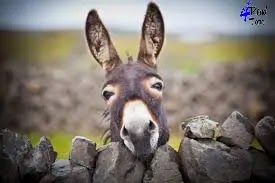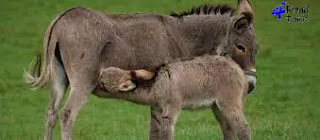Information about donkeys Learn about the donkey animal with pictures
- donkey:
Donkeys are members of the equine family, although donkeys and horses represent two completely different species. They evolved into working beasts used to transport people or packs after domestication in Egypt and North Africa, where they were used for meat and milk. They are slower than horses but sure. Historians believe that the domestication of donkeys increased the mobility of pastoral cultures in the ancient world. They evolved into working beasts used to transport people or packs after domestication in Egypt and North Africa, where they were used for meat and milk.
- The scientific name of the donkey:
The classification of these animals falls within the family Equidae and the genus Equus - meaning horse in Latin. There are two main types of wild asses: the Asian donkeys, whose range extends from the Red Sea to northern India and Tibet, giving rise to several subspecies, and the African branch of the species. Among the Asian subspecies in the taxon are Equus hemionus hippos (Syrian wild donkey) and E Equus hemionus khud (Indian wild donkey).
Equus Africanus asinus is the scientific name for all current domesticated donkeys, and they are descended from African wild asses found mostly in North Africa between the Mediterranean and the Sahara.
- The appearance and behavior of donkeys:
These animals come in different sizes and colors. From hoof to shoulder, the wild species is around 49 inches tall and weighs about 551 pounds. Domesticated donkeys come in different sizes, depending on how they were raised.
They are usually 36 inches to 48 inches from hoof to shoulder and weigh 400 to 500 pounds. The Sicilian donkey is the smallest, measuring only 24 inches in length while the Mallorcan donkey is around 62 inches long. The mammoth stoke is the world's largest domestic breed, measuring 56 inches from hoof to shoulder and weighing 950 pounds.
The colors of these animals range from white and gray to black. Gray is the most common color, followed by brown, then black, and roan (white with an admixture of pigmented hair). They often have a dark strip of fur under their backs from mane to tail and across their shoulders. They have short, erect manes and a tail that looks more like a cow's than a horse's. They have very long ears that are dark at the tip and base. Their enormous ears are also used in a fan-like manner to keep donkeys cool.
These donkeys enjoy being around other donkeys and frequently form bonds with them. When their species is not present, they will often bond with horses, mules, and other small animals.
Once a human being has gained their trust, they are often willing and willing partners. Because of their ability to form strong bonds, separating a pair of interconnected donkeys can cause stress that leads to hyperlipidemia, a blood condition that can lead to a heart attack or stroke.
Despite their reputation for stubbornness, this trait is a characteristic of self-preservation, which is why it is difficult to force a donkey to do something that it considers dangerous. It's also tough to read their body language because it's less expressive than horses'.
The slight widening of their eyes can be misunderstood as a curiosity when it means stress or fear. Their lack of movement when watching something they fear is part of their low-flight response. They often defend themselves by biting, hitting their front hooves, or kicking their hind legs.
These animals are intelligent, cautious, kind, playful, and eager to learn from the moment they are born until the end of their lives.
Domesticated donkeys are more territorial than horses, which is why they are sometimes used to protect herds of sheep and goats from predators, often trampling on anything they feel is a threat. Horses are the major animals of burden and modes of transportation in many places of the world where they cannot readily live or where there is tremendous poverty. They rest during the hottest part of the day and are most active in the morning and evening when they travel with the herd and eat.
- home of donkeys:
Domesticated donkeys are found in various cultures around the world, although they are best adapted to warm, dry environments, particularly marginal desert areas. This adaptation provided them with a strong immune and digestive system. Wild donkeys are usually solitary and do not form a harem, with each adult creating a home range. A single jack may dominate the breeding over a wide area.
If a pet donkey becomes feral and can choose its own home, it will seek out a warm environment. Wild donkeys can be found in North Africa's deserts and savannas, as well as the Arabian Peninsula and the Middle East. These animals also live in Turkey, China, and the northern regions of Pakistan, India, Nepal, and Bhutan. Their booming brays, which can be heard for three kilometers, may serve as a mechanism for donkeys in the wild to communicate with one another.
- Donkey breeding, children, and age:
Foals weigh between 19 and 30 pounds (about as heavy as a small dog) and can stand and breastfeed 30 minutes after birth. Jennies are very protective of their foals, as they are weaned at around five months. A donkey can mate when it is two years old.
Donkeys are choosy about who they keep in their head, but they don't mind who they mate with and frequently breed with other Equus species. The offspring between a donkey and a mare is called a mule, which is also valued as both working and riding animals. Less common is the offspring between stallion and jenny, known as shinny. Both types of crosses are usually sterile. Donkeys can also breed zebras with the offspring often called zonkey.
A donkey's typical lifespan is 25-30 years, however, they can live considerably longer. The oldest recorded donkey was the US domesticated female donkey who lived to be 54 years old.
- young donkeys:
Young horses, donkeys, and striped zebras can stand on their legs shortly after they are born. She swayed and trembled at first, but soon found her balance. And in about an hour you can walk well. After a day or two, she can run fast enough to keep her flock constantly moving from pasture to pasture. Then her only protection from a hungry lion looking for prey is to flee from its path.
- the number of donkeys:
The world is inhabited by more than 50 million donkeys, most of which are domesticated, and they primarily live in underdeveloped countries where they work or transport goods. Despite their large numbers, few animals within each breed are pure.
Many species of the wild donkey are on the verge of extinction. The African wild ass is highly endangered, according to (IUCN), with only 23 to 200 adults remaining. With a population of around 28,000, Asian wild donkeys (also known as Asian wild donkeys) are considered near-threat species. The majority of dangers come from humans, either directly or indirectly through habitat loss.
Donkeys are descended from the Nubian and Somali wild donkeys. Between 6000 and 5000 BC, these animals were initially domesticated in Western Asia and Egypt.
Donkeys are a specific species in the equine family. A mule is a cross between a female horse and a male donkey, also known as a jack, which explains the term donkey.
Dogs are like coyotes that can threaten donkeys. However, once the donkey learns that the dog does no harm, it will usually begin to get along with the dog.
The scientific term for a donkey is Equus Asinus.
Donkeys can live from 15 to 30 years.
A donkey can attain speeds of up to 15 mph
Predators of donkeys include foxes, wolves, and lions.
A donkey's litter size averages one.
Donkeys have domesticated for the first time 5,000 years ago!
Donkeys live in arid forests and deserts.
Donkeys have stocky bodies.
Donkeys eat grass, herbs, and vegetables.
Donkeys are inherently stimulated by their natural environment, which requires them to wander and continually look for food. Domesticated donkeys live in a restricted environment, which can lead them to overfeed, become bored, and have poor social interaction.
Donkeys belong to the kingdom Animalia.
Donkeys belong to the family Chordata.
Donkeys belong to the class Mammalia.
Donkey is a member of the group Equidae.
What is the number of donkeys?
Donkeys belong to the order Perissodactyla.
What gender do donkeys belong to?
Donkeys belong to the genus Equus.
Donkeys covered with fur.






Comments
Post a Comment
You can write your comment here